lies like truth: December 2009 Archives
 Here is a short list of my favorite local productions of new plays which had their world premieres in the Bay Area in 2009. The list is not in any particular order:
Here is a short list of my favorite local productions of new plays which had their world premieres in the Bay Area in 2009. The list is not in any particular order:In the Next Room (or The Vibrator Play) by Sarah Ruhl (pictured), Berkeley Rep
Faust, Part 1 by Mark Jackson, Shotgun Players
Legs and All by Summer Shapiro, Climate Theater
Rabbi Sam by Charlie Varon, The Marsh
This World in a Woman's Hands by Marcus Gardley, Shotgun Players
Here's to more great new theatrical productions in 2010!
Faust, Part 1 by Mark Jackson, Shotgun Players
Legs and All by Summer Shapiro, Climate Theater
Rabbi Sam by Charlie Varon, The Marsh
This World in a Woman's Hands by Marcus Gardley, Shotgun Players
Here's to more great new theatrical productions in 2010!
But as is so often the case with films of this ilk, producers throw money at special effects at the expense of the basics. While Avatar titillates the eyes, it addles the brain with its nonsensical, cliche-ridden plot, trite characters, and thinly-veiled, heavy-handed political morality.
The folks involved in making this film should learn a lesson or two from Pixar Animation Studios. Pixar's filmmakers understand that unless you have the fundamentals of story in place, you will never have a great movie on your hands, no matter how wizard-like your special effects. Films like Ratatouille, Toy Story, and Up will endure and even become classics because of their unforgettable characters and clever writing. The animation supports these elements and brings them alive. The story is never in service to the special effects.
In Avatar, and many other CGI movies like it, the reverse is true. Ultimately, the movie will probably go down in history as no more than a footnote in the development of CGI technology.
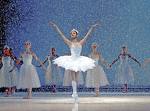 A bit of a roundup before I hop on a plane to Peoria, Illinois, of all places...
A bit of a roundup before I hop on a plane to Peoria, Illinois, of all places...1. It was weird experiencing the San Francisco Ballet's uber-traditional production of The Nutcracker after checking out Mark Morris' campy-irreverent The Hard Nut at Cal Performances the previous week. It would have probably made more sense to see the productions the other way around. Choreographically-speaking, SF Ballet's production is much more interesting. The character dances are especially magnetic to watch -- incredible leg-work from the trio of men who performed the Russian dance after bursting out of three enormous Faberge eggs. One thing I preferred about The Hard Nut, however, was its use of a real children's choir. San Francisco Ballet employed a tinny sounding synthesizer for the short section involving children's voices. This was very disappointing. Surely this company, which is, after all, one of the flagship ballet organizations in the world, could stretch to hiring real singers? I suspect that children's choirs come cheap. And the vocalists are, on average, small, so they don't take up too much space on stage or in the pit.
2. Having watched a production of David Greenspan's gender-bending play, She Stoops to Comedy, at SF Playhouse last night, I've come to the conclusion that few playwrights make me feel quite as overtly like a shrink as Greenspan does. The writer has a wonderful way of turning stage conventions on their head and he has a great feel for dialogue and timing. But he clearly uses theater as a way to work out his enormous personal issues. I felt like I had been giz'd over by the time I left the theater last night. The play was quite fun and the cast was good. But She Stoops isn't as tightly-constructed, hilarious and thoughtful as Greenspan's Dead Mother, which the Jewish Theatre produced last year.
3. Finally, a shameless plug before I leave (I won't be blogging for a few days while traveling): VoiceBox, a new public radio about the art of singing and the best of the vocal music scene from the Bay Area and beyond which I am producing and hosting, is launching on January 1 on KALW 91.7 FM San Francisco. The first weekly broadcast airs from 10-11pm Pacific Time and the inaugural show, entitled "why we sing", endeavors to tackle some fundamental questions about the human voice. You can also catch the broadcast via live streaming on the KALW website. To find out more about the series, visit the VoiceBox website.
It only remains for me to wish you all a songful and restful holiday.
 I was on the 51 bus yesterday traveling between Oakland and Berkeley. Somewhere along College Avenue, an angular young man got on the bus and sat opposite me. He was muttering to himself and looking very shifty. He kept saying, in quite an upper class, tight-lipped colonial era British-sounding accent, "I have a difficult thing to do" and "I have decided they cannot live."
I was on the 51 bus yesterday traveling between Oakland and Berkeley. Somewhere along College Avenue, an angular young man got on the bus and sat opposite me. He was muttering to himself and looking very shifty. He kept saying, in quite an upper class, tight-lipped colonial era British-sounding accent, "I have a difficult thing to do" and "I have decided they cannot live."Although people are always muttering to themselves on Bay Area buses, this man's insistent and slightly menacing vocal repetitions and stooped over frame made me wary. Plus, he was carrying a big, black backpack. I found myself leaning in a little and perking up my ears to see if could hear a ticking sound.
Just then, a blonde, female UC Berkeley student got on the bus with a couple of very heavy suitcases. The young man immediately jumped up to help her. They struck up a conversation.
Much to my embarrassment and amusement, the man told the woman that he was practicing his lines for a play in which he was scheduled to take on the role of an Afrikaaner. I felt his accent needed a little work, personally. He probably did too, hence all the repetition. "I wish they'd cast me as Nelson Mandela," he told the woman with a laugh before launching into his version of Mandela's diction. "I can do a very good impression of him."
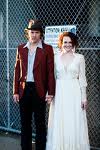 How do you make a work as well-known and didactic as The Threepenny Opera feel fresh? The piece is so often performed and makes such a strong and obvious statement about societal corruption, that any production of the three-hour-plus-long Weill-Brecht magnum opus is bound to fall short of surprises, even if the songs are a hell of a lot of fun to listen to and sing.
How do you make a work as well-known and didactic as The Threepenny Opera feel fresh? The piece is so often performed and makes such a strong and obvious statement about societal corruption, that any production of the three-hour-plus-long Weill-Brecht magnum opus is bound to fall short of surprises, even if the songs are a hell of a lot of fun to listen to and sing.Shotgun Players' current production of the musical play, directed by Susannah Martin, manages to make a virtue out of the heavy-handedness of the material through the energy of the cast, the unusual characterizations of some of the actors, and the strangely compelling mashup of different cultural idioms and styles.
The grungy, punk-underworld setting isn't particularly original. But it is greatly enlivened by the unconventional approach that some of the actors take to their characters. Kelsey Venter's Polly isn't a flighty, naive debutante; she's canny, self-aware and tough. As the prostitute Jenny, Beth Wilmurt is the calm in the eye of the storm. While all the other characters are losing their heads around her, this Jenny is quietly proud, self-assured and, above all, pragmatic. Wilmurt's and Venter's takes on their characters change the way we feel about Macheath -- as charismatic as is Jeff Wood's kid glove-wearing miscreant, he no longer calls all the shots. This considerably increases the dramatic - and sexual - tension of the story.
What I also enjoyed about this production was the wonderful clash of cultures. Weill and Brecht conceived the work in 1920s Germany, basing it on an 18th century ballad play, The Beggars Opera, set in London by John Gay; The Threepenny Opera is set in Victorian-era London; Shotgun transforms the setting to the 1960s -- there's a Sex Pistols / Malcolm MacLaren meets Vivienne Westwood vibe to the work. The lively adaptation -- provided by UK dramatist-directors Jeremy Sams (lyrics) and Robert MacDonald (book) -- is full of contemporary British idioms and references. Words like "shag" and "bollocks" abound, and I even caught a reference to the 1980s British ice-skating duo, Torville and Dean, which I imagine must be lost on many US theatregoers. It's a matter of great delight to me that the actors still approach the work in a very American way -- they speak with their regular accents, letting the Englishisms trip off their tongues as if they were born into a culture which routinely uses the word "bugger" rather than "dang."
I imagine that this slapped-together-feeling blend must strike some audience members and critics as messy and bizarre. But I found the culture clash compelling. The tensions between the acting, text and setting made me sit up and listen more carefully. I wasn't bored for a moment. Weill and Brecht came to life.
 Since the publication of Chris Anderson's book The Long Tail a few years ago, niche concepts and organizations have become more accepted and even celebrated in culture. The public isn't so surprised about the existence of tiny splinter groups and weird cultural interests than they used to be. Some niches are nichier than others though. Selling w-scraped oboe reeds made with goldbeater skin or running a dance studio dedicated to a genre from a tiny Pacific island, might seem like losing propositions. But these days -- thankfully -- these kinds of activities are flourishing, perhaps more than ever before. Hooray for the Internet!
Since the publication of Chris Anderson's book The Long Tail a few years ago, niche concepts and organizations have become more accepted and even celebrated in culture. The public isn't so surprised about the existence of tiny splinter groups and weird cultural interests than they used to be. Some niches are nichier than others though. Selling w-scraped oboe reeds made with goldbeater skin or running a dance studio dedicated to a genre from a tiny Pacific island, might seem like losing propositions. But these days -- thankfully -- these kinds of activities are flourishing, perhaps more than ever before. Hooray for the Internet!The enrapturing 30-strong, San Francisco vocal ensemble The Conspiracy of Beards is a perfect example of a "micro niche" that works.
The ensemble, which I experienced in concert for the first time on Saturday night at The Rickshaw Stop in Hayes Valley, occupies a very specific niche. The group is all-male, a cappella and focuses solely on singing vocal arrangements of the songs of Leonard Cohen.
Despite the narrow constraints of its makeup and mission, the group seems to have a large and enthusiastic local following. The niche serves The Beards well -- it's so precise that it helps the group build a strong image and make a virtue out of its narrow-mindedness. Plus, the singers all look like they're having a terrific time on stage. They look sharp in their ramshackle, "garage sale-chic" suits and assorted fedoras. Many of them, though not all, even have beards. The arrangements of Cohen's repertoire are simple yet soulful. The harmonies are basic and the melodies come out strongly. The vocal parts share the glory - sometimes the melody is in the tenor line, at other times in the baritone, and sometimes it's in the bass. The Beards also make an appealing sound. They sing tunefully, yet the unrefined strength of the voices brings to mind a group of men singing around a piano in a bar after a soccer match. In short, the group is great fun to watch in action.
The Beards' niche is I think the main factor that draws people in. The Rickshaw Stop concert was packed and people reacted thunderously to the ensemble. I was so moved by the performance that I started trying to think of ways to infiltrate the group without having to go through a sex change. And I'd like to date every one of the singers.
 My friend and comedian Will Franken has taken up singing. Until he joined a church choir in San Francisco last week, he'd pretty much decided he couldn't hold a tune. In fact, when he was at high school he made fun of people who sang. To his surprise, Will found himself taking to the choir quite naturally. I asked him to share some thoughts about his debut:
My friend and comedian Will Franken has taken up singing. Until he joined a church choir in San Francisco last week, he'd pretty much decided he couldn't hold a tune. In fact, when he was at high school he made fun of people who sang. To his surprise, Will found himself taking to the choir quite naturally. I asked him to share some thoughts about his debut:I joined the choir last week at a church up in Bernal Heights. There's only like five or six of us--only two males, excluding the choir director.
I've been going here since September and spent the first two months bitching about how nobody was playing the organ. (The choir director uses a guitar--very unorthodox for a Catholic Church; even though there's a swanky pipe organ readily available and supposedly he knows how to play it, but just prefers guitar.)
Anyway, I suppose I decided to make lemons out of lemonade. Most of the congregation doesn't sing along with the hymns, so I started experimenting to see if I could match the notes he was singing. Later I heard from my godmother that the director was asking about me and whether or not I would be interested in joining the choir. My artistic ego thus stroked, I reconciled myself with the guitar.
My first rehearsal was so wild. I was really nervous, almost like I was getting ready to do one of my comedy shows. He sat me right up in the front and positioned a mike directly in front of me. As we were rehearsing, the church filled up for the 10 a.m. Mass. He reminded us that we weren't here to do a show, but to do a job; i.e., to take part in the liturgy. I followed the notes with my finger and watched for the chord changes and was amazed at the vibrato that was naturally coming out of my mouth. When the notes went low, I brought my head down and when the notes went high, I raised my head up. It was like the notes were dictating my physical movement. It was, for lack of a better term, really fucking fun. I don't know how else to describe it. I think now a lot of being able to sing has to do with confidence -- like so many other things in life, I suppose. Just jumping in without a net. We even did some a cappella stuff. . .what a rush! Thursday we're going to rehearse for the upcoming caroling at the midnight Christmas Mass. I can't wait. And maybe if I get in good with this guy, I can sweet-talk him into playing the organ again."
Will is performing at The Herbst Theatre on New Year's Eve. I don't know if he'll be treating audiences to his new-found vibrato that night, but if you're in the Bay Area on December 31, you should definitely check out his virile strain of absurdist comedy.
 Ever since I first heard about NBC's new a cappella singing competition, The Sing-Off, in the summer, I've been excited about the new series. Certainly it seems to build on the current wave of interest sweeping the country (and other places like the UK) in group singing. BBC Radio's The Choir and Fox's Glee are just two examples of mainstream media projects devoted to ensemble singing in recent times. While Glee and The Choir have made for delightful viewing and listening, the same cannot be said of NBC's new show.
Ever since I first heard about NBC's new a cappella singing competition, The Sing-Off, in the summer, I've been excited about the new series. Certainly it seems to build on the current wave of interest sweeping the country (and other places like the UK) in group singing. BBC Radio's The Choir and Fox's Glee are just two examples of mainstream media projects devoted to ensemble singing in recent times. While Glee and The Choir have made for delightful viewing and listening, the same cannot be said of NBC's new show.I'm going to see how the series progresses before passing final judgement. But I have to say that I'm not encouraged by the debut. Part of the problem is the host. Nick Lachey is bland to look at and listen to. Plus, the poorly written, cliche-ridden script doesn't help the situation. The series has two articulate judges: singer-songwriter Ben Folds and Boyz II Men member Shawn. But the third judge -- Pussycat Dolls front woman, Nicole Scherzinger -- is barely coherent and can't seem to say anything remotely incisive. At best, all she can manage is "wow."
Another issue is the repetitive and dull editing -- the entire show follows the same formula throughout, with a behind-the-scenes look at each choir, a quick live performance, comments from the judges and then a post-mortem.
Finally, I have to say that I'm mostly underwhelmed by the talent, Three of the groups look promising. The all-male ensemble from Puerto Rico, Nota, have great moves and spirit, and The Beelzebubs, a large all-male consort from Tufts University, sing with sharp articulation and possess a quirky sense of humor. I'm also impressed by SoCal, a group from Los Angeles, whose energy and tunefulness make me want to get up and dance.
I could do without the religious proselytizing of the two faith-based groups though. And I heard some very wonky intonation and dynamic control in the initial heat. Plus, some of the arrangements aren't great. The all-female group Noteworthy, is a case in point, with its caffeinated, squeaky renditions of "Viva la Vida" and "Hold On."
It's difficult to imagine that the show's producers didn't receive hundreds of applications from ensembles for the series. I know for certain that there are better groups out there than most of the ones that were selected to participate in the series. We'll see what happens between now and December 21, when The Sing-Off reaches its finale. I can't say that I'll be waiting with baited breath until then.
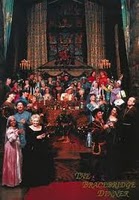 In the spirit of catching up and filling in...
In the spirit of catching up and filling in...1. A Chanticleer Christmas at The Cathedral of Christ the Light, Oakland: Very happy to say that my doubts about the acoustic of the new Oakland Cathedral (which I touched upon briefly last Sunday in my latest column for The New York Times) were put to rest by the primo a cappella ensemble's Christmas concert. Gospel music might not work well in the cavernous space -- heavy bass and drums swallow everything else up. But the lines and lyrics in Chanticleer's Friday night program were warm and clear. The group's program was oddly downbeat compared to previous years. There were very few energetic numbers. Even the ensemble's statutory, crowd-pleasing final medley of spirituals didn't reach the usual heights of flamboyance. With an emphasis on more sedate repertoire such as Franz Biebl's famous "Ave Maria" and feathery carols like Elizabeth Poston's gorgeous "Jesus Christ the Apple Tree", the mood was largely dignified. The music was as lovely as ever, but I kind of missed the zanier side of Chanticleer at Christmas this year.
2. Mark Morris' The Hard Nut at Zellerbach Hall, Berkeley: I am embarrassed to say that until this weekend, I had never made it to Berkeley to see this Bay Area yuletide staple. Glad I finally did. Morris goes all-out on kitsch, with red-eyed rats marauding around the stage and more drag queens than you could fill a Christmas stocking with. The opening "cocktail party" sequence got on my nerves a bit -- too much miming and flailing of limbs and running around the stage. But when the cast actually started dancing, my heart warmed to the production. I love Morris' sense of humor and sexual egalitarian approach to costuming and dance steps -- men should wear tutus and dance en pointe more often. But in general, the pleasure of The Hard Nut lies with its spectacular design and sense of fun than it does with the choreography, which doesn't feature much in the way of innovation.
3. The Bracebridge Dinner at The Awahnee Lodge, Yosemite: This 84-year-old tradition continues to almost sell-out the story book Awahnee Lodge in the heart of the Yosemite Valley. This amazes me as you could fly an entire family of four to Europe and back for the cost of a Bracebridge package for two people. The Valley is beautiful at this time of year, with deep snow and blue skies. The Bracebridge soiree, considered to be one of the country's foremost holiday pageant experiences, is a wonderful, albeit cheesy experience. There's as much theatricality in the serving of the yummy six course meal (which featured baron of beef, crab, and rabbit) as there is in the performance itself, what with an army of waiters streaming out of the kitchen in perfect red coattails to deliver steaming platters with gliding elegance. The whole event runs four hours, giving guests a refreshingly languorous amount of time to digest and chat between courses. The play features around 40 people dressed in well-crafted and colorful Renaissance garb acting out a yarn from Washington Irving's Sketchbook entitled "A Christmas at Bracebridge Hall". It swings between bad doggerel and great a cappella carol singing. It's all quite entertaining in an old-fashioned sort of a way. A highlight is the Squire of Bracebridge's fool, who plays a mean tuba while shunting audience members off their chairs. He makes his way across the room by hopping from one guest's chair to another -- all the while playing his tuba. If I had a lot of money to burn, I would enjoy coming back again for this convivial event.
 My alma mater, Cambridge University, is celebrating its 800th anniversary right now. If I were responsible for putting together the celebrations for such an auspicious occasion, I probably wouldn't do it the way in which the organizers of the Bay Area 800th anniversary party did it.
My alma mater, Cambridge University, is celebrating its 800th anniversary right now. If I were responsible for putting together the celebrations for such an auspicious occasion, I probably wouldn't do it the way in which the organizers of the Bay Area 800th anniversary party did it.The ingredients of last night's soiree at the St Francis Yacht Club were not the freshest to say the least. The champagne quickly ran out at the two-hour-long party and half an hour before the end, the houselights were turned up and the waiters started coming around with glasses of water. The vice-chancellor made an exceedingly boring speech. Much of her talk revolved around saying how she wasn't going to ask us for money on this celebratory occasion. But the statement more or less amounted to the same thing as asking for money.
A particular low point of the evening was the playing of a short video made to mark the 800th anniversary. The video, which was unimaginatively shot and edited, featured a bunch of cheesy images of Cambridge (the Bridge of Sighs, the King's Chapel, people gliding down the River Cam in a punt etc). It also had a bunch of Cambridgey types looking directly at the camera and saying things like "Cambridge!" and "success!" and "cows!" It was all very embarrassing. I imagine this video is being played at 800th anniversary parties all over the world, which is a very sad thought indeed.
Still, I did meet a few nice people. And it was lovely to be part of the celebrations in some small way, even if the result was entirely half-baked.
On another note: I am heading out on assignment on Sunday and won't be posting again until Wednesday. Toodle-pip until then.

 Perhaps it's the war-mongering, economically-difficult times we currently live in, but theatre companies seem to be achieving great commercial success in San Francisco these days with shows that draw inspiration from the black and white movie thrillers and romances of yore to create a new breed of theatrical escapism.
Perhaps it's the war-mongering, economically-difficult times we currently live in, but theatre companies seem to be achieving great commercial success in San Francisco these days with shows that draw inspiration from the black and white movie thrillers and romances of yore to create a new breed of theatrical escapism.As I sat in the Curran Theatre last night watching the touring Broadway production of a show based on Alfred Hitchcock's The 39 Steps, Kneehigh Theatre's recent tour of a show based on Noel Coward's Brief Encounter kept popping into my mind. I guess my reaction isn't that surprising considering the fact that the Kneehigh show played right next door to The 39 Steps, at the Geary Stage, just a couple of months ago.
These two theatrical homages to the silver screen have a lot in common. Both employ extreme physicality as a way to make fun of - with great affection - hammy early movie and vaudeville acting styles. Both rely on a barebones approach to staging, with the storytelling emanating more out of the actors' physical ingenuity and agility and snappily-written scripts than through snazzy lighting, costume and set effects. And both take a highly romanticized view of the good old days and feed on a collective desire to retreat from reality with a ripping good yarn.
Neither production thrilled me, to be honest. The schtick gets a bit predictable and tiring after a while. And there's only so many wildly imaginative gimmicks and bits of theatrical schtick that an audience member can take in an evening.
But it's interesting to see how positively audiences are responding to these kinds of shows. They offer pure escapism and they're quite a bit of fun. I guess that's what people need right now.
 I came across a beautiful if slightly knotty quote yesterday in Thomas Forrest Kelly's book about classical music world premieres that changed the course of music history, First Nights.
I came across a beautiful if slightly knotty quote yesterday in Thomas Forrest Kelly's book about classical music world premieres that changed the course of music history, First Nights.This is the Fifteenth Century Florentine humanist, Marsilio Ficino, on the power of song:
"Remember that song is the most powerful imitator of all things. For it imitates the intentions and affectations of the soul, and speech, and also reproduces bodily gestures, human movements and moral characters, and imitates and acts everything so powerfully that it immediately provokes both the singer and hearer to imitate and perform the same things."
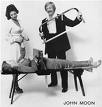 With the holiday season upon us, the performers of live theatre, circus, magic, and comedy shows are working their audience participation gambits to the max, despite the fact that most members of the public tend to shy away from being picked to help a magician out with a card trick or do a funny dance routine with a clown. But for those exhibitionists among us who quite like to get hauled up on stage every now and again, especially after having one too many yuletide eggnog cocktails, here are a few pointers to help improve your chances of earning a momentary place in the spotlight:
With the holiday season upon us, the performers of live theatre, circus, magic, and comedy shows are working their audience participation gambits to the max, despite the fact that most members of the public tend to shy away from being picked to help a magician out with a card trick or do a funny dance routine with a clown. But for those exhibitionists among us who quite like to get hauled up on stage every now and again, especially after having one too many yuletide eggnog cocktails, here are a few pointers to help improve your chances of earning a momentary place in the spotlight:1. Wear flashy clothes. The performers will better be able to pick you out from the crowd.
2. If asked to show your willingness to volunteer by raising an arm, make sure you have something eye-catching protruding from the end of it, like a glittery fairy wand or light saber.
3. If the audience is collectively asked to select a volunteer based on some form of pre-screening, make sure you make yours racy or controversial, e.g. tell an anecdote that involves sex with animals. And if the voting takes place using a clap-o-meter, be sure to clap very quietly for any rivals.
4. Turn up at the theatre with someone of the opposite sex. For some reason, heterosexual couples are often audience participation targets.
5. Bury your face in your program or do whatever you can to look like you'd just about die if you were picked on. Reluctance is often a big turn on for performers, especially those that like a challenge.
 Had three classical music concert experiences this weekend, none of them "professional" in the standard sense of the word, but all of them encouraging in the sense that they demonstrate how great musicianship exists at the grassroots level in even the most adverse of financial climates. I'd like to share with you a few thoughts about each one:
Had three classical music concert experiences this weekend, none of them "professional" in the standard sense of the word, but all of them encouraging in the sense that they demonstrate how great musicianship exists at the grassroots level in even the most adverse of financial climates. I'd like to share with you a few thoughts about each one:1. International Orange Chorale at the Solarium Public Space, 55 Second Street, San Francisco: This San Francisco-based a cappella vocal ensemble, named after the official color of the Golden Gate Bridge, performs all its concerts for free. The singers volunteer their services (they all make a living doing other things such as working at Google) but musical standards are high. The eclectic program featured everything from madrigals by Thomas Morley and Claudio Monteverdi to works by local, contemporary composers like Robin Estrada and Joseph Gregorio. The group also performed a fiendishly difficult but mesmerizing world premiere by Shaffer McGee -- "Death of a ball turret gunner." The Solarium space is a delightful, casual place to hear choral music. It's bright and has a bright acoustic.
2. School of the Arts (SOTA) Choral and Orchestral Concert at School of the Arts Auditorium, 555 Portola Drive, San Francisco: SOTA is in a state of financial disarray. The classrooms are run-down and the place hasn't seen a lick of paint in decades. Nevertheless, the teachers and students soldier on. The concert they pulled off at the weekend is testimony to the creative brilliance of the SOTA community. Although the program (like many school concerts) was rather long, the various choirs and orchestras presented a diverse range of work in a polished and spirited manner. I was particularly taken with the candlelit opening processional by the Chamber Choral Ensemble which featured two spectral setting of "O Magnum Mysterium" - one an anonymously composed plainchant and the other by Tomas Luis de Victoria. I also really loved the Vocal Jazz Ensemble's take on "Fragile" by Sting (arranged by Phil Matson.) The soloist, a small 13 or 14-year-old by the name of Rafael, has the makings of a young Sinatra. His voice is mellow and smooth like a good cup of Venezuelan coffee and he is sweetly handsome. The orchestral offerings were less even. A performance of Arcangelo Corelli's Concerto Grosso in g minor had a lot of life to it though the intonation was sometimes fuzzy. The combined choral and orchestral performance of Padre G B Martini's "Domine, ad Adjuvandum Me Festina" was lively and bold. But Gabriel Faure's "Cantique de Jean Racine" was less successful. It lacked energy and the necessary sostenuto to make the piece come alive.
3. Taping of NPR's From the Top at Dinkelspiel Auditorium, Stanford University Campus, Palo Alto: What a treat to experience the recording of this great young people's classical music showcase in front of a live audience in the show's 10th anniversary year. The producers assembled an eclectic group of young prodigies. My favorite was a scrawny bespectacled cellist by the name of Nathan Chan who had a great sense of humor and played Mark Summer's whimsical, jazz- and blues-infused melody "Julie-O" with verve and pluck. I also enjoyed From the Top alumnus Evan Premo's duets for double bass and voice - the "Seasonal Song Cycle" - which the composer-bassist performed with his wife, Mary Bonhag. Less compelling was the Palo Alto Chamber Orchestra's take on the same Corelli concerto I'd heard the previous evening at SOTA. The playing, though more technically precise and in tune, lacked soul. It was heavy and angular and Beethoven-like. I wanted the music to dance.
All three of the above experiences demonstrate that music-making is alive and well in the Bay Area at the grassroots level. If only more money would find its way into the system though. This would help to make the experiences even better - both for audiences and for the creators of the work.
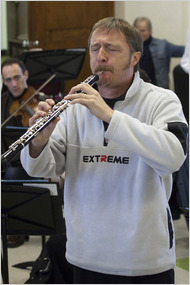 Three thoughts today aimed at three different audiences:
Three thoughts today aimed at three different audiences:1. For all you teetotalers out there: I am impressed with the amount of interest that my blog post of a couple of days ago about arts reviewers' drinking habits has generated. One person wrote this morning to say that critics should behave like any professional would, and abstain from drinking a drop on the job. But have you ever heard of a businessman's lunch that didn't include at least one glass of wine if not an entire bottle?
2. For all you circus fans out there: I experienced Cirque du Soleil's latest touring production, Ovo, in San Francisco last night at the start of its travels. Of course the acrobatics and clowning are pretty flawless. And I saw a couple of acts I'd never seen before, including the heart-stopping combination climbing wall/trampoline finale. The free popcorn and half-time cupcakes with blue and orange frosting were a lovely bonus. And The insect-themed costumes were glorious. But all in all I found the experience to be tiring. The show was about half an hour too long. And the music, which at one point mashed Beethoven's Symphony Number 5 against "La Cucaracha", made my stomach lurch.
3. For all you oboists out there: As an oboist, I was thrilled to read Daniel Wakin's coverage of a recent oboists' get-together in New York in The New York York Times. (See picture of the event's biggest star, Berlin Philharmonic principle oboist Albrecht Mayer, above.) Fame at last! The article makes our weird breed of midnight reed scrapers and ducky honkers feel like rockstars.
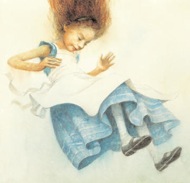 The Flavorpill Daily Dose newsletter hit my inbox yesterday with a lovely item, which I wanted to share with you all.
The Flavorpill Daily Dose newsletter hit my inbox yesterday with a lovely item, which I wanted to share with you all.I'm a huge fan of Alice in Wonderland and can't wait to check out the upcoming Tim Burton film about my favorite literary heroine and read a copy of the latest edition of Lewis Carroll's classic with illustrations by the brilliant Australian artist, Robert Ingpen (see one of his drawings for the new edition to the left.)
Alice has been a subject of delight for visual artists for more than 150 years. John Tenniel's drawings for the original, 1865 edition of the book will always have a special place in my heart. But there are so many other great filmmakers and illustrators who've turned their skills and imaginations to portraying the characters in Carroll's writing. Click this link for a run-down of some of the most famous ones, from Mabel Lucie Atwell to Disney.
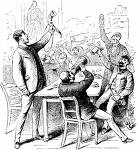 An amusing article by Mark Brown in the UK Guardian got me thinking about the rules of engagement when it comes to arts critics drinking before they turn up to review shows. According to the story, the playwright Timberlake Wertenbaker accused critics, who gave her new play The Line mixed reviews, of being "in no fit condition to review a play after a boozy theatre awards lunch." The article continues:
An amusing article by Mark Brown in the UK Guardian got me thinking about the rules of engagement when it comes to arts critics drinking before they turn up to review shows. According to the story, the playwright Timberlake Wertenbaker accused critics, who gave her new play The Line mixed reviews, of being "in no fit condition to review a play after a boozy theatre awards lunch." The article continues:"Wertenbaker believes that the actors were not given a fair crack of the whip because many of the critics had spent the day being liberally wined and dined at the Evening Standard theatre awards - a four-hour affair at the Royal Opera House that involved a champagne reception followed by lunch and as much wine as they wanted to drink. She said some critics had had the grace to say they would come on a different night, but most came after the lunch."
Following in the noble footsteps of such famous theatre-reviewing lushes as Kenneth Tynan, I suspect that the London theatre critics are better able to hold their drink than many other breeds of journalist. It's also worth mentioning that a few of the critics who reacted negatively to The Line, like The Daily Telegraph's Charles Spencer, are devoted teetotalers. If Wertenbaker's play didn't win raves, it's probably largely the fault of the play, not the booze.
Turning up drunk to review a show is of course a major professional no-no, alongside leaving a theatre at intermission and sleeping with the leading gent or lady. But it's my personal opinion that unless you're the greatest lightweight in the world, imbibing one glass of wine or pint of beer prior to going to review a show isn't off-limilts. It certainly shouldn't impact one's reception of a performance.
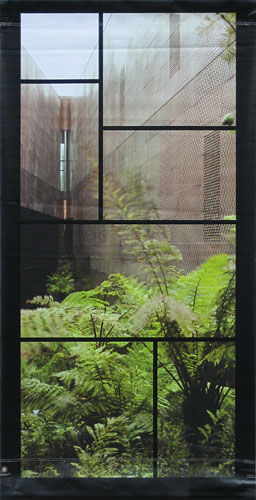 Like many cities in the US, San Francisco's streets are lined with colorful banners advertising various cultural organizations and events. I wouldn't be surprised if many people in this city owe their knowledge of the existence of The New Century Chamber Orchestra and the Disney Family Museum to the flying banners bearing the names of these organizations strapped to the tops of lampposts around town.
Like many cities in the US, San Francisco's streets are lined with colorful banners advertising various cultural organizations and events. I wouldn't be surprised if many people in this city owe their knowledge of the existence of The New Century Chamber Orchestra and the Disney Family Museum to the flying banners bearing the names of these organizations strapped to the tops of lampposts around town.Just like billboard posters, you never see people putting these banners up or taking them down. They appear and disappear as if by magic, it seems, as if an army of elves shuttles in in the night to do the work. Where do the banners come from and where do they go?
It turns out that there are dedicated banner companies like BetterWall which oversee the elves.
The company is currently touting three new banners with San Francisco connections:
1) Victor Moscoso "Psychedelic Experience": This banner features a poster from 1966 promoting a concert at the Avalon Ballroom in San Francisco featuring Oxford Circle, Big Brother & the Holding Company, and Lee Michaels. The poster was created by graphic artist Victor Moscoso, renowned as one of "The Five" big artists of the Family Dog collective.
2) Marc Chagall's "Music": Featured on banners from the Contemporary Jewish Museum, Chagall's image of "Music" was created as a mural for Moscow's Jewish Chamber Theater in 1920 as part of a series which also included "Dance", "Drama", and "Literature". His interpretation of "Music" features dreamlike imagery of a fiddler on the shtetl rooftops - it is, in fact, the image from which the 1964 musical "Fiddler on the Roof" took its name.
3) De Young Museum "Fern Courtyard" (pictured): The contemporary architecture of Herzog & de Meuron's de Young museum is the backdrop for the museum's 200-foot long Fern Courtyard. A verdant green space, the courtyard sits at the heart of the de Young museum.
BetterWall works with arts institutions to sell the banners that have been hung on city street-posts to promote their exhibitions and allegedly shares proceeds with the museums. The company says that it keeps over 10 tons of vinyl out of landfills each year as a result.
Prices for used banners range from $300 - $800. Quite a nice, non-bank-breaking collectors item, I think. I, for one, wouldn't mind the Fern Courtyard for my apartment.
Blogroll
AJ Ads
AJ Blogs
AJBlogCentral | rssculture
About Last Night
Terry Teachout on the arts in New York City
Terry Teachout on the arts in New York City
Artful Manager
Andrew Taylor on the business of arts & culture
Andrew Taylor on the business of arts & culture
blog riley
rock culture approximately
rock culture approximately
critical difference
Laura Collins-Hughes on arts, culture and coverage
Laura Collins-Hughes on arts, culture and coverage
Dewey21C
Richard Kessler on arts education
Richard Kessler on arts education
diacritical
Douglas McLennan's blog
Douglas McLennan's blog
Dog Days
Dalouge Smith advocates for the Arts
Dalouge Smith advocates for the Arts
Flyover
Art from the American Outback
Art from the American Outback
Life's a Pitch
For immediate release: the arts are marketable
For immediate release: the arts are marketable
Mind the Gap
No genre is the new genre
No genre is the new genre
Performance Monkey
David Jays on theatre and dance
David Jays on theatre and dance
Plain English
Paul Levy measures the Angles
Paul Levy measures the Angles
Real Clear Arts
Judith H. Dobrzynski on Culture
Judith H. Dobrzynski on Culture
Rockwell Matters
John Rockwell on the arts
John Rockwell on the arts
State of the Art
innovations and impediments in not-for-profit arts
innovations and impediments in not-for-profit arts
Straight Up |
Jan Herman - arts, media & culture with 'tude
Jan Herman - arts, media & culture with 'tude
dance
Foot in Mouth
Apollinaire Scherr talks about dance
Apollinaire Scherr talks about dance
Seeing Things
Tobi Tobias on dance et al...
Tobi Tobias on dance et al...
jazz
Jazz Beyond Jazz
Howard Mandel's freelance Urban Improvisation
Howard Mandel's freelance Urban Improvisation
ListenGood
Focus on New Orleans. Jazz and Other Sounds
Focus on New Orleans. Jazz and Other Sounds
Rifftides
Doug Ramsey on Jazz and other matters...
Doug Ramsey on Jazz and other matters...
media
Out There
Jeff Weinstein's Cultural Mixology
Jeff Weinstein's Cultural Mixology
Serious Popcorn
Martha Bayles on Film...
Martha Bayles on Film...
classical music
Creative Destruction
Fresh ideas on building arts communities
Fresh ideas on building arts communities
The Future of Classical Music?
Greg Sandow performs a book-in-progress
Greg Sandow performs a book-in-progress
Overflow
Harvey Sachs on music, and various digressions
Harvey Sachs on music, and various digressions
PianoMorphosis
Bruce Brubaker on all things Piano
Bruce Brubaker on all things Piano
PostClassic
Kyle Gann on music after the fact
Kyle Gann on music after the fact
Sandow
Greg Sandow on the future of Classical Music
Greg Sandow on the future of Classical Music
Slipped Disc
Norman Lebrecht on Shifting Sound Worlds
Norman Lebrecht on Shifting Sound Worlds
The Unanswered Question
Joe Horowitz on music
Joe Horowitz on music
publishing
book/daddy
Jerome Weeks on Books
Jerome Weeks on Books
Quick Study
Scott McLemee on books, ideas & trash-culture ephemera
Scott McLemee on books, ideas & trash-culture ephemera
theatre
Drama Queen
Wendy Rosenfield: covering drama, onstage and off
Wendy Rosenfield: covering drama, onstage and off
lies like truth
Chloe Veltman on how culture will save the world
Chloe Veltman on how culture will save the world
visual
Aesthetic Grounds
Public Art, Public Space
Public Art, Public Space
Another Bouncing Ball
Regina Hackett takes her Art To Go
Regina Hackett takes her Art To Go
Artopia
John Perreault's art diary
John Perreault's art diary
CultureGrrl
Lee Rosenbaum's Cultural Commentary
Lee Rosenbaum's Cultural Commentary
Modern Art Notes
Tyler Green's modern & contemporary art blog
Tyler Green's modern & contemporary art blog
